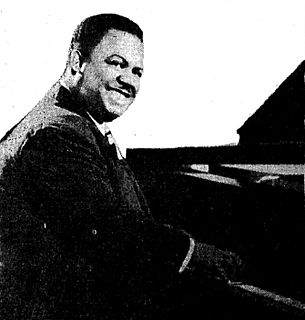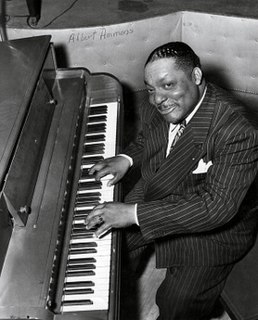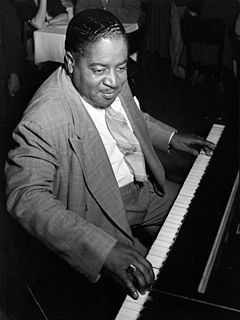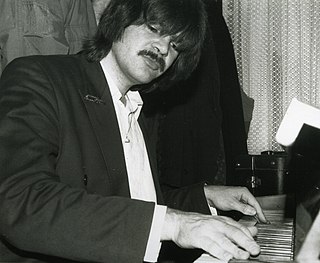James Edwards Yancey was an American boogie-woogie pianist, composer, and lyricist. One reviewer described him as "one of the pioneers of this raucous, rapid-fire, eight-to-the-bar piano style".
Boogie-woogie is a genre of blues music that became popular during the late 1920s, developed in African-American communities since 1870s. It was eventually extended from piano, to piano duo and trio, guitar, big band, country and western music, and gospel. While standard blues traditionally expresses a variety of emotions, boogie-woogie is mainly associated with dancing. The genre had a significant influence on rhythm and blues and rock and roll.

Anderson Meade Lewis, known as Meade Lux Lewis, was an American pianist and composer, remembered for his playing in the boogie-woogie style. His best-known work, "Honky Tonk Train Blues", has been recorded by many artists.

Albert Clifton Ammons was an American pianist and player of boogie-woogie, a blues style popular from the late 1930s to the mid-1940s.

Pete Johnson was an American boogie-woogie and jazz pianist.
Clarence Smith, better known as Pinetop Smith or Pine Top Smith, was an American boogie-woogie style blues pianist. His hit tune "Pine Top's Boogie Woogie" featured rhythmic "breaks" that were an essential ingredient of ragtime music, but also a fundamental foreshadowing of rock & roll. The song was also the first known use of the term "boogie woogie" on a record, and cemented that term as the moniker for the genre.

George Washington Thomas Jr. was an American blues and jazz pianist and songwriter. He wrote several influential early boogie-woogie piano pieces including "The New Orleans Hop Scop Blues", "The Fives", and "The Rocks", which some believe he may have recorded himself under the name Clay Custer.

Hersal Thomas was an American blues pianist and composer. He recorded a number of sides for Okeh Records in 1925 and 1926.
"Honky Tonk Train Blues" is a song written by Meade Lux Lewis, and first recorded in 1927. A proto boogie-woogie song, it has many of the traits that would come to be identified with rock and roll. It is also the first recorded use of the term "honky tonk" in a song.

Clarence Lofton, credited as Cripple Clarence Lofton, was an American boogie-woogie pianist and singer born in Tennessee.
Major Merriweather, better known as Big Maceo Merriweather, was an American pianist and blues singer. He was mainly active in Chicago through the 1940s.

Axel Zwingenberger is a German blues and boogie-woogie pianist and songwriter.
Bob Zurke was an American jazz pianist, arranger, composer and briefly a bandleader during the Swing era.
Mr. B., is an American boogie-woogie pianist.
John Cocuzzi is an American jazz, blues, and swing musician who specializes in the vibraphone and piano, as well as drums. His primary influences on vibraphone are Lionel Hampton and Red Norvo, while his piano playing is influenced by piano greats from both the jazz and blues worlds.
Bob Baldori, also known as "Boogie Bob", is an American rock, blues, boogie musician and attorney. He plays the guitar, piano, harmonica and piano.

Maurice Rocco was an American pianist, singer, actor, and composer known for playing boogie-woogie piano and his disdain for using a piano bench. He was a top nightclub and theater draw in the 1940s, and made several film appearances. He toured the United States, Canada, and Europe before becoming a fixture in Bangkok, Thailand, where he was murdered.

Boogie Woogie is a compilation album containing four 10-inch, 78 rpm records of boogie-woogie music. The songs on the album were recorded over a period of three years from 1936 to 1939, then released in 1941 on this compilation album by Columbia Records (C44). Artists featured on the album include Harry James, Count Basie, Big Joe Turner, and the three prominent boogie-woogie pianists of the time, Albert Ammons, Pete Johnson, and Meade Lux Lewis.
Arthur Migliazza is an American blues and boogie woogie pianist.








